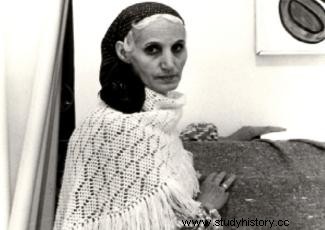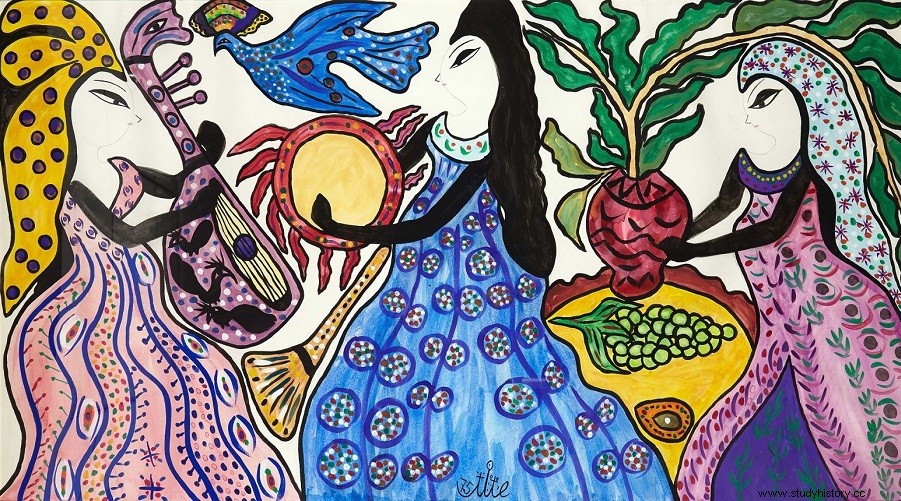Algerian painter, Baya Mahieddine (1931 – 1998) rose to fame at the age of sixteen for his colourful, refined and intimate art.
A young artist

Fatma Haddad, who will be known as Baya, was born on December 12, 1931 in Fort-de-l'Eau (today Bordj el Kiffan) near Algiers, in the department of Algiers during the colonial period. Orphaned at the age of 5, the little girl was taken in and brought up by her grandmother, who worked on a horticultural farm. Already an artist at heart, Baya draws and creates terracotta models. His works caught the attention of the sister of the farm owner, Marguerite Caminat.
At first, Marguerite employed little Baya, then eleven years old, as a servant, then gradually became her protector. A painter herself, she teaches the child to read and write and encourages him to develop his artistic talents by providing him with the necessary materials for painting and modeling. Baya draws on a vast imagination to create female figures, birds, landscapes, painted in bright colors with dominant pinks, blues and oranges. His art, considered to belong to the naive art movement, is intimate and with clean lines.
Paris exhibition
Convinced of the talent of her adopted daughter, Marguerite uses her connections in the artistic and cultural world to disseminate her works. She thus presented them to her friend the sculptor Jean Peyrissac, who in turn showed them to the artist, patron and gallery owner Aimé Maeght. The latter then decided to organize an exhibition of Baya's works in his Parisian gallery. The exhibition catalog is prefaced by the writer André Breton, who writes: “I speak, not like so many others to deplore an end but to promote a beginning and on this beginning Baya is queen. The beginning of an age of emancipation and harmony, a radical break with the previous one and one of the main levers for which is for man the systematic, ever greater impregnation of nature. »
Sixteen-year-old Baya goes to Paris for the exhibition, which is a great success; Vogue magazine in particular devotes an article to the young artist. In Paris, Baya met many artists, including the painter Georges Braque. During her stay in France, she also spent some time making modeling in the Madoura workshop, in Vallauris in the south of France, where she rubbed shoulders with Picasso, who was impressed and interested in her art.
Wedding time
In 1953, Baya married musician El Hadj Mahfoud Mahieddine, nearly 30 years her senior. This marriage marks his retirement from public life and a long break in his artistic and professional career. For the next ten years, she retired to the domestic sphere and devoted herself to the education of the six children to whom she gave birth.
This period of withdrawal also coincided with the Algerian war, which raged for eight years from 1954 to 1962. Baya is not aware of any public position on the subject. Although linked to his private life, his withdrawal undoubtedly also allowed him to avoid the political instrumentalization of his destiny as a successful young artist in the midst of the colonial period. In July 1962, the independence of Algeria was recognized.
Career recovery

After independence, in 1963, Baya's friends encouraged him to get back to work and the Museum of Fine Arts in Algiers acquired some of his works. The artist takes back his brushes, and will not leave them until his death. She widens the format of her paintings and adds to her female figures, flowers and birds, everyday objects such as musical instruments, fruits, furniture.
Baya exhibits again, during the exhibition Algerian Painters in 1963 in Algiers, the following year in Paris then regularly in France, notably in Marseilles, Belgium and in the Arab world. Appreciated and recognized for her art, she presents old and new works.
Baya died at the age of sixty-six, in November 1998.
